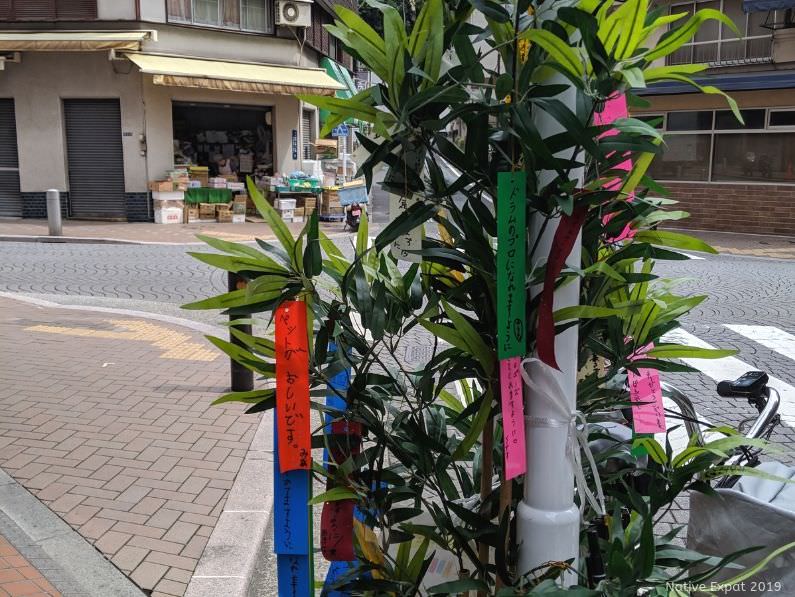In July along Azabujuban shopping street, bamboo sticks decorated with colourful paper with wishes written on them pop up🎋. It slightly reminds me of “Christmas in July” in Australia where Christmas trees pop up again in July simply because it’s winter in Australia and Australians can celebrate Christmas like the Northern Hemisphere folks.

I do remember July 7th is 七夕 (Tanabata) where we make wishes and there’s a story about a star crossed lovers who can only meet on this day if the night sky is clear. Yet, my memory about it is quite fuzzy. I did some research and here it is.

The story of the star crossed lovers – Orihime and Hikoboshi

This is an ancient Chinese story that was introduced to Japan with a number of slight variations. One of them starts off with a hardworking and talented weaver called 織姫 (Orihime or a literal translation being a weaving princess) whose father was the god of sky or universe, 天亭(Tentei).
Orihime’s beautiful fabrics were very popular among the gods and Tentei was very proud. To reward his hard-working daughter, he decided to find her a husband.
He found a beautiful and kind cowherd, 彦星 (Hikoboshi, or literally the “trusted star”) 🌟who Tentei introduced to Orihime and the two fell madly in love.
So much so that neither hardly worked which made Tentei mad. He decided to separate them across 天の川 (Amanogawa, meaning heaven’s river or in English, the Milky Way)🌌.
This intervention wasn’t successful either as devastated Orihime could hardly focus on weaving.
Wanting Orihime to work and to not be too sad, Tentei said that if they both work hard, Orihime and Hikoboshi can meet once a year on July 7th. When the night is clear, the magpies create a bridge with their wings for Orihime to cross the Milky Way. However, when it rains on the night (as it often does due to the rainy season), the magpies cannot fly and Orihime and Hikoboshi has to wait another year.
It’s on July 7 as the two stars representing the lovers Vega (Orihime) and Altair (Hikoboshi) shine the brightest⭐.
….so what’s with the bamboo?
When Tanabata was introduced, it was only celebrated by the aristocrats who presented poems under the starry night. After Edo period, the festival became mainstream and the general public started to celebrate Orihime and Hikoboshi. Rather than poems, people started to write wishes on colourful piece of paper called 短冊 (tanzaku) and decorated the bamboo.
Bamboo was used for this celebration as bamboos grow strongly, quickly and straight towards the heaven that it is believed they will carry the wishes written on tanzaku to heaven.

As the raining season continues into July and today starting off with a cool rainy day, I fear that Orihime and Hikoboshi have to wait another year…
Side note: The Japanese way to enjoy soba
As summer in Japan is humid and hot, many enjoy a light meal like cold soba noodles that you dip into a dipping sauce.
I did notice at the end of a meal, people ask for そばゆ(sobayu) where people pour it into the remaining dipping sauce to drink it.
I understood the concept, but to clarify, I asked my colleague (who loves soba so much that he and his friends venture out on a soba eating weekend trips). Sobayu is the hot water that the soba was cooked in and you pour it into the dipping sauce to not waste the dipping sauce.
Most people won’t do this at home but will ask for it at a good soba restaurant. Another colleague added that all the nutrients from soba come out of the noodle when it’s cooked and to avoid wasting the nutrients, like rutin, sobayu is drunk.
Rutin is a type of Polyphenol (yes, like the red wine and dark chocolates) and is good for your veins and lowers your cholesterol.
The texture is similar to the boiling water after you boil some spaghetti – milky and kind of starchy. On its own, it won’t be tasty but by diluting it with そばつゆ (sobatsuyu, soba dipping sauce ), it’s healthy and follows one of the Japanese values – avoid wasting anything.